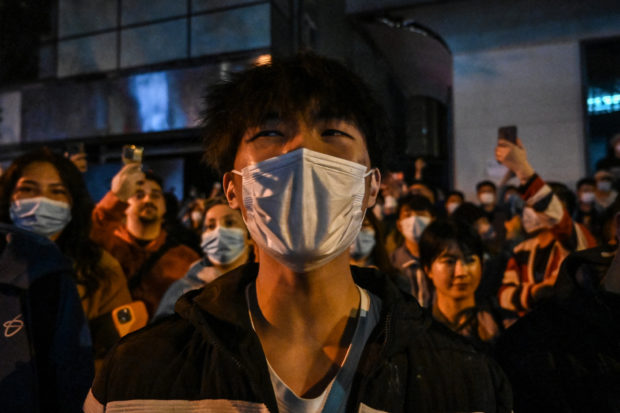
People gather on a street in Shanghai on November 27, 2022, where protests against China’s zero-COVID policy took place the night before following a deadly fire in Urumqi, the capital of the Xinjiang region. (Photo by Hector RETAMAL / AFP)
BEIJING, China — Discontent has brewed for months in China over the country’s zero-COVID policy with relentless mass testing, localized lockdowns, and travel restrictions pushing many across the country to the brink.
And those frustrations have now spilled onto the streets of some of China’s biggest cities as protesters call for an end to lockdowns and greater political freedoms.
Here is a timeline of key COVID-related protests since the start of the year.
Shanghai frustrations
A grueling lockdown in Shanghai from late March bought the first visible glimmers of widespread dissent against COVID restrictions.
The measures sparked sporadic protests and food shortages – both almost unheard of in China’s richest metropolis.
In April, a six-minute video montage of audio clips of despairing residents quickly went viral in China before being censored.
Social media users posted the video in multiple formats to evade censorship, in the biggest wave of online protest since the Wuhan Covid whistleblower and doctor Li Wenliang died in February 2020.
READ: China COVID-19 cases hit fresh record high after weekend of protests
Campus protests
In May, hundreds of students at one campus of the elite Peking University in Beijing protested against strict lockdown measures that allowed more freedom of movement for staff than students.
The rare protest was later defused after officials agreed to relax some restrictions.
Campuses across China have been locked down for virtually the entire pandemic, barring visitors and preventing students from returning home easily.
Henan bank protests
From May to July, hundreds of bank depositors who lost their money when multiple rural banks in Henan province froze deposits gathered in the provincial capital of Zhengzhou to demonstrate.
READ: Shanghai hit by COVID-19 protests as anger spreads across China
Some protesters reported that their COVID health codes inexplicably turned red upon arrival at Zhengzhou, barring them from travel, and accused officials of tampering with the system.
Health codes are used in contact tracing and linked to ID documents. In many cities across China, scanning a health code is a requirement to enter public spaces and use public transport.
Tibet protests
In October, hundreds in the tightly policed Tibetan regional capital of Lhasa staged a rare demonstration, against a harsh lockdown that persisted for almost three months.
Videos showed hundreds of people – who appeared to be mostly migrant workers of Han Chinese ethnicity – marching through the streets, demanding to be allowed to return home.
Protests were geolocated to an area near the Potala Palace, the traditional residence of the Dalai Lama, Tibet’s exiled spiritual leader.
Beijing bridge
That same month, just days before China’s ruling party was set to open a landmark congress, a defiant protester draped two hand-painted banners with slogans criticizing the Communist Party’s policies on the side of a bridge in Beijing.
READ: Blank sheets of paper become symbol of defiance in China protests
“No Covid tests, I want to make a living. No Cultural Revolution, I want reforms. No lockdowns, I want freedom. No leaders, I want to vote. No lies, I want dignity. I won’t be a slave, I’ll be a citizen,” one banner read.
The other banner called on citizens to go on strike and remove “the traitorous dictator Xi Jinping.”
Guangzhou clashes
In November, protesters in the southern metropolis of Guangzhou clashed with police, after lockdowns were extended due to a surge in infections.
Videos circulating on social media and verified by AFP showed hundreds taking to the street, some tearing down cordons intended to keep locked-down residents from leaving their homes.
“No more testing,” protesters chanted, with some throwing debris at police.
A man is arrested while people gathering on a street in Shanghai on November 27, 2022, where protests against China’s zero-COVID policy took place the night before following a deadly fire in Urumqi, the capital of the Xinjiang region. (Photo by Hector RETAMAL / AFP)
Foxconn protests
Violent protests erupted at the world’s largest iPhone factory, in the city of Zhengzhou, Henan province.
Hundreds of staff at the plant, owned by Taiwanese tech giant Foxconn, marched because of disputes over pay and conditions, with some clashes between protesters and riot police.
Foxconn later offered new recruits a bonus equivalent to $1,400 to end their contracts and leave, in a bid to stamp out the unrest.
The sprawling factory with more than 200,000 workers has been under lockdown since October after a surge in COVID infections.
Urumqi protests
Hundreds took to the streets of Xinjiang’s regional capital Urumqi in late November, according to videos circulating on social media, calling for an end to lockdown measures that have affected the region for the past three months.
Footage partially verified by AFP showed them massing outside the city government offices during the night, chanting: “Lift lockdowns!”
The protests occurred after a fire killed 10 people in a city apartment block. Social media users claimed lockdown measures prevented residents from leaving their homes in time and delayed access to the compound by emergency services.
The rare mass protests in the tightly policed region sparked a wave of similar unrest and mourning vigils across Chinese cities and campuses.